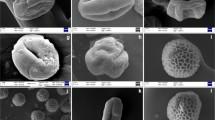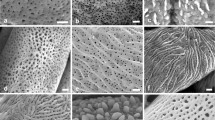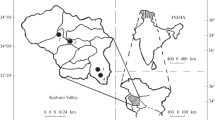Abstract
The present study aimed to understand the pollen morphological variation among and within the Rosa L. species of Western Himalaya, India, and to investigate whether the pollen characters may help to distinguish these species of roses. The pollen morphology of nine Rosa species viz. R. canina L., R. centifolia L., R. damascena Mill., R. foetida var. persiana (Lem.) Rehder, R. moschata Herrm, R. multiflora Thunb, R. nanothamnus Boulenger, R. webbiana Wall. ex Royle, and R. macrophylla Lindl were studied. A total of 31 accessions of roses were collected from Jammu and Kashmir, Ladakh, and Himachal Pradesh. Ten quantitative characters, i.e., length of the polar axis (P), length of equatorial axis (E), exine thickness (Ex), length of colpi (LeC), width of striae (Sr), width of groove (Gr), number of striae (Ns), Polar area index (PAI) and P/E ratio were studied. The measurements and observations were carried out with both light microscopy and scanning electron microscopy. Pollen grains of all the studied species were tricolporate. Prolate and subprolate shapes were the dominant pollen shape types. The highest and lowest polar axis length was observed for R. canina (32.73 µm) and R. moschata (25.42 µm), respectively. The average colpi length in the studied species was 22.19 µm, with R. macrophylla having a minimum length of 13.42 µm and R. canina with a maximum length of 34.03 µm. Results of the principal component analysis indicated that the principal component (PC1) attributed 42.10% of the total variation, and positively associated with P, E, LeC, and Ns. Exine ornamentation almost distinguished all the species of Rosa in this study.








Similar content being viewed by others
References
Agarwal A, Gupta V, Haq SU, Jatav PK, Kothari SL, Kachhwaha S (2019) Assessment of genetic diversity in 29 rose germplasms using SCoT marker. J King Saud Univ Sci 31:780–788
Almeida GS, Mezzonato-Pires AC, Mendonca CBF, Goncalves-Esteves V (2018) Pollen morphology of selected species of Piriqueta Aubl. (Passifloraceae sensu lato). Palynology 43:43–52
Ambasta SP (1986) The useful plants of India. In: CSIR New Delhi, publication and information directorate, India
Andrews HC (1805) Roses, or, a monograph of the genus Rosa: containing colored figures of all known species and beautiful varieties. Taylor R. and Co., London
Bai JR, Zhang QX, Luo L, Pan HT, Yu C (2011) Pollen morphology of some Chinese traditional roses. Bull Bot Res 31:15–23
Baker JG (1869) A monograph of the British roses. Bot J Linn Soc 11:197–243
Bashir KMI, Awan FS, Khan IA, Khan AI, Usman M (2014) Identification and authentication of Rosa species through development of species-specific SCAR marker(s). Genet Mol Res 13:4130–4139
Besse C, Cao MQ, Gandelin MH, Zhang D (2000) Evaluation of AFLPs for variety identification in modern rose (Rosa hybrida L.). Int Symp Mol Markers Charact Genotypes Identif Cultiv Hortic 546:351–357
Broertjes C, van Harten AM (1978) Application of mutation breeding methods in the improvement of vegetatively propagated crops. Elsevier, Amsterdam
Cheikh-Affene ZB, Haouala F, Harzallah-Skhiri F (2015) Morphometric variation and taxonomic identification of thirteen wild rose populations from Tunisia. Acta Bot Croat 74:1–7
Chopra VL, Singh M (2013) Ornamental plants for gardening. Scientific Publishers, Jodhpur
Chowdhery HJ, Wadhwa BM (1984) Flora of Himachal Pradesh, vol 1. Botanical Survey of India Publication, Delhi
Debener T, Bartels C, Mattiesch L (1996) RAPD analysis of genetic variation between a group of rose cultivars and selected wild rose species. Mol Breed 2:321–327
Devi U, Seth MK, Sharma P, Rana JC (2013) Study on ethnomedicinal plants of Kibber Wildlife Sanctuary: a cold desert in trans Himalaya, India. J Med Plant Res 7:3400–3419
Dhyani D, Singh S (2014) Potential wild rose germplasm of western Himalayas-conservation, evaluation, and registration. Indian J Agric Sci 84:229–235
Duthie JF (1971) Flora of the Upper gangetic plain and of the adjacent Siwalik and sub-Himalayan tracts. International Book Distributors, Dehradun
eFloras (2019) Published on the Internet. Missouri Botanical Garden, St. Louis, MO and Harvard University Herbaria, Cambridge, MA. https://www.efloras.org. Accessed 02 December 2019
Eide F (1981) Key for northwest European Rosaceae pollen. Grana 20:101–118
Erdtman G (1952) Pollen morphology and plant taxonomy of angiosperms. Almqvist and Wiksell, Stockholm
Esselink GD, Smulders MJ, Vosman B (2003) Identification of cut rose (Rosa hybrida) and rootstock varieties using robust sequence tagged microsatellite site markers. Theor Appl Genet 106:277–286
Fatemi N, Attar F, Assareh MH, Hamzehee B (2012) Pollen morphology of genus Rosa L. (Rosaceae) in Iran. Iran J Bot 18:284–293
Fogle HW (1977) Identification of clones within four tree fruit species by pollen exine pattern. J Am Soc Hortic Sci 102:552–560
Fougere-Danezan M, Joly S, Bruneau A, Gao XF, Zhang LB (2015) Phylogeny and biogeography of wild roses with specific attention to polyploids. Ann Bot 115:275–291
Ghosh A, Saha I (2017) Pollen morphological study of some selected Indian taxa of Rosaceae. Indian J Pure Appl Biol 32:121–130
Gu C, Robertson KR (2003) Rosa L. In: Team FoCe (eds) Flora of China, Missouri Botanical Garden Press, St. Louis, MO
Halbritter H, Ulrich S, Grimsson F, Weber M, Zetter R, Hesse M, Buchner R, Svojtka M, Frosch-Radivo A (2018) Illustrated pollen terminology. Springer, Berlin
Hammer O, Harper DAT, Ryan PD (2001) PAST: Paleontological statistics software package for education and data analysis. Palaeontol Electron 4:9
Hebda RJ, Chinnappa CC (1990) Studies on pollen morphology of Rosaceae in Canada. Rev Palaeobot Palynol 64:103–108
Hebda RJ, Chinnappa CC (1994) Studies on pollen morphology of Rosaceae. Acta Bot Gall 141:183–193
Hebda RJ, Chinnappa CC, Smith BM (1988) Pollen morphology of the Rosaceae of Western Canada I. Agrimonia to Crataegus Grana 27:93–113
Henker H (2000) Rosa. In: Hegi G (ed) Illustrierte Flora von Mitteleuropa. Band 4/2c. Parey Buchverlag, Berlin, pp 1–108
Hesse M, Halbritter H, Zetter R, Weber M, Buchner R, Frosch-Radivo A, Ulrich S (2009) Pollen terminology: an illustrated handbook. Springer, Vienna
Hooker JD (1879) Flora of British India. Reeve & Co., London
Hutchinson J (1964) The genera of flowering plants. Oxford University Press, London
Jacob Y, Pierret V (2000) Pollen size and ploidy level in the genus Rosa. Acta Hortic 508:289–292
Kachroo P, Bansilal S, Dhar U (1977) Flora of Ladakh: an ecological and taxonomical appraisal. International Book Distributors, Dehradun
Kalkman C (2004) Rosaceae. In: Kubitzki K (ed) The families and genera of vascular plants VI Flowering plants—dicotyledons. Springer, Berlin, pp 386–443
Kaul K, Karthigeyan S, Dhyani D, Kaur N, Sharma RK, Ahuja PS (2009) Morphological and molecular analyses of Rosa damascena× R. bourboniana interspecific hybrids. Sci Hortic 122:258–263
Kaul VK, Gujral RK, Singh B (1999) Volatile constituents of the essential oil of flowers of Rosa brunonii Lindl. Flavour Frag J 14:9–11
Kiani M, Zamani Z, Khalighi A, Fatahi R, Byrne DH (2010) Microsatellite analysis of Iranian Damask rose (Rosa damascena Mill.) germplasm. Plant Breed 129:551–557
Koopman WJM, Wissemann V, de Cock K, Huylenbroeck JV, de Riek J, Sabatino GJH, Visser D, Vosman B, Ritz CM, Maes B, Werlemark G, Nybom H, Debener T, Linde M, Smulders MJM (2008) AFLP markers as a tool to reconstruct complex relationships: a case study in Rosa (Rosaceae). Am J Bot 95:353–366
Lewis WH (1957) A monograph of the genus Rosa in North America east of the Rocky Mountains. Ph.D. Thesis submitted to University of Virginia, Virginia
Marcucci MC, Sansavini S, Ciampolini F, Cresti M (1984) Distinguishing apple clones and cultivars by surface morphology and pollen physiology. J Am Soc Hortic Sci 109:10–19
Matsuta N, Omura M, Akihama T (1982) Difference in micromorphological pattern on pollen surface of Japanese Pear cultivars. Jpn J Breer 32:123–128
Menge U (1985) Identification of rose varieties using pollen surface patterns/identification of Rose cultivars by patterns of pollen grain surfaces. Hort Sci 501:1–9
Mohapatra A, Rout GR (2006) Optimization of primer screening for evaluation of genetic relationship in rose cultivars. Biol Plantarum 50:295–299
Nadeem M, Wang X, Akond M, Awan FS, Riaz A, Younis A (2014) Hybrid identification, morphological evaluation and genetic diversity analysis of Rosa hybrida by SSR markers. Aust J Crop Sci 8:183
Nand K, Naithani S (2018) Ethnobotanical uses of wild medicinal plants by the local community in the Asi Ganga sub-basin, Western Himalaya. J Complement Med Res 9:34–46
Nilsson O (1997) Rosa. In: Davis PH (ed) Flora of Turkey and the East Aegean Islands. Edinburgh University Press, Edinburgh, pp 106–128
Pal BP (1991) The rose in India. Publication and Information Division, ICAR, New Delhi
Panwar S, Singh KP, Sonah H, Deshmukh RK, Prasad KV, Sharma TR (2015) Molecular fingerprinting and assessment of genetic diversity in rose (Rosa × hybrida). Indian J Biotechnol 14:518–524
Polyakovaa TA, Gataulina GN (2008) Morphology and variability of pollen of the genus Spiraea L. (Rosaceae) in Siberia and the far east. Contemp Prob Ecol 1:420–424
Popek R (1996) Biosystematic studies on the type of Rosa L. in Poland and neighboring countries. In: Scientific Publisher of the College of Pedagogy, Krakow. Prace Monograficzne, vol 218
Punt W, Hoen PP, Blackmore S, Nilsson S, Le Thomas A (2007) Glossary of pollen and spore terminology. Rev Palaeobot Palyno 143:1–81
Rao RR, Sharma BD (1990) A manual for herbarium collections. Botanical Survey of India, Kolkata
Reitsma TJ (1966) Pollen morphology of some European rosaceae. Acta Bot Neerl 15:290–307
Riaz A, Hameed M, Khan AI, Younis A, Awan FS (2011) Assessment of biodiversity based on morphological characteristics and RAPD markers among genotypes of wild rose species. Afr J Biotechnol 10:12520–21252
Samiei L, Naderi R, Khalighi A, Shahnejat-Bushehri AA, Mozaffarian V, Esselink GD, Osaloo K, Smulders MJ (2010) Genetic diversity and genetic similarities between Iranian rose species. J Hortic Sci Biotech 85:231–237
Schori M, Fumess CA (2014) Pollen diversity in Aquifoliales. Bot J Linn Soc 175:169–190
Shameh S, Alirezalu A, Hosseini B, Maleki R (2019) Fruit phytochemical composition and color parameters of 21 accessions of five Rosa species grown in North West Iran. J Sci Food Agric. https://doi.org/10.1002/jsfa.9842
Sharma BM, Kachroo P (1981) Flora of Jammu and Plants of neighborhood, vol 1. Bishen Singh Mahendra Pal Singh, Dehradun
Shinwari MI, Khan MA (2004) Pollen morphology of wild roses from Pakistan. Hamdard Med 47:5–13
Singh G, Kachroo P (1976) Forest flora of Srinagar and plants of neighborhood. Bishen Singh Mahendra Pal Singh, Dehradun
Singh K, Sharma YP, Gairola S (2020) Morphological characterization of wild Rosa L. germplasm from the Western Himalaya, India. Euphytica 216:41
Song JH, Oak MK, Roh HS, Hong SP (2017) Morphology of pollen and orbicules in the tribe Spiraeeae (Rosaceae) and its systematic implications. Grana 56:351–367
TPL (2019) The plant list, version 1.1. https://www.theplantlist.org. Accessed 02 December 2019
Ueda Y (1992) pollen surface morphology in genus Rosa and related genera. Jpn J Palynol 38:94–105
Ueda Y, Okada Y (1994) Discrimination of rose cultivar groups by pollen surface structure. J Jpn Soc Hortic Sci 694:601–607
Ueda Y, Tomita H (1989) Morphometric analysis of pollen exine pattern in Roses. J Jpn Soc Hortic Sci 58:211–220
Uggla M, Gao X, Werlemark G (2003) Variation Among and Within Dogrose Taxa (Rosa sect. caninae) in fruit weight, percentages of fruit flesh and dry matter, and vitamin C content. Acta Agric Scand Sect B Plant Soil Sci 53:147–155
Wissemann V (2003) Conventional taxonomy of wild roses. In: Roberts A, Debener T, Gudin S (eds) Encyclopedia of rose sciences. Elsevier Science, Oxford, pp 111–117
Wronska-Pilarek D (2011) Pollen morphology of Polish native species of the Rosa genus (Rosaceae) and its relation to systematics. Acta Soc Bot Pol 80:221–232
Wronska-Pilarek D, Jagodzinski AM (2009) Pollen morphology variability of Polish native species of Rosa L. (Rosaceae). Dendrobiology 62:71–82
Wronska-Pilarek D, Jagodzinski AM (2011) Systematic importance of pollen morphological features of selected species from the genus Rosa (Rosaceae). Plant Syst Evol 295:55–72
Wronska-Pilarek D, Jagodzinski AM, Bocianowski J, Janyszek M (2015) The optimal sample size in pollen morphological studies using the example of Rosa canina L. (Rosaceae). Palynology 39:56–75
Acknowledgements
Authors thank Director, IIIM Jammu, for providing necessary facilities to carry out the work. Authors are thankful to SERB DST for financial assistance under Start-Up Research Grant (Young Scientist), Grant No YSS/2015/000442. KS acknowledges the financial support provided by CSIR in the form of a JRF/SRF fellowship. CSIR-IIIM Publication No. CSIR-IIIM/IPR/00178.
Author information
Authors and Affiliations
Corresponding author
Ethics declarations
Conflict of interest
The authors declare that they have no conflict of interest.
Additional information
Publisher's Note
Springer Nature remains neutral with regard to jurisdictional claims in published maps and institutional affiliations.
Rights and permissions
About this article
Cite this article
Singh, K., Sharma, Y.P., Sharma, P.R. et al. Pollen morphology and variability of the Rosa L. species of Western Himalaya in India. Genet Resour Crop Evol 67, 2129–2148 (2020). https://doi.org/10.1007/s10722-020-00967-8
Received:
Accepted:
Published:
Issue Date:
DOI: https://doi.org/10.1007/s10722-020-00967-8




